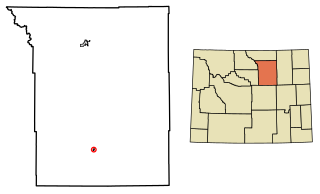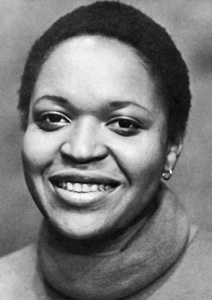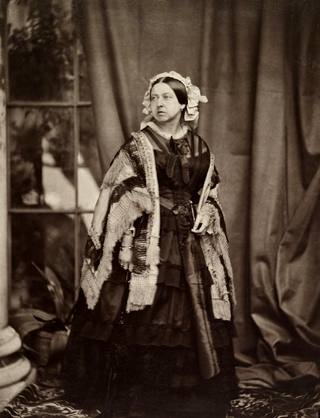Related Research Articles

The Johnson County War, also known as the War on Powder River and the Wyoming Range War, was a range conflict that took place in Johnson County, Wyoming from 1889 to 1893. The conflict began when cattle companies started ruthlessly persecuting alleged rustlers in the area, many of whom were settlers who competed with them for livestock, land and water rights. As violence swelled between the large established ranchers and the smaller settlers in the state, it culminated in the Powder River Country when the former hired gunmen to invade the county. The gunmen's initial incursion in the territory alerted the small farmers and ranchers, as well as the state lawmen, and they formed a posse of 200 men that led to a grueling stand-off. The siege ended when the United States Cavalry on the orders of President Benjamin Harrison relieved the two forces, although further fighting persisted in the following months.

Kaycee is a town in Johnson County, Wyoming, United States. The population was 247 at the 2020 census. It is home to a museum that preserves the cattle ranching heritage of the area, especially the history of the Johnson County War.
Mitchell Parish was an American lyricist, notably as a writer of songs for stage and screen.

Michael Landon was an American actor and filmmaker. He is known for his roles as Little Joe Cartwright in Bonanza (1959–1973), Charles Ingalls in Little House on the Prairie (1974–1983), and Jonathan Smith in Highway to Heaven (1984–1989). Landon appeared on the cover of TV Guide 22 times, second only to Lucille Ball.

American Public Television (APT) is an American nonprofit organization and syndicator of programming for public television stations in the United States. It distributes public television programs nationwide for PBS member stations and independent educational stations, as well as the Create and World television networks.

The 1900 House is a historical reenactment reality television series made by Wall to Wall/Channel 4 in 1999. The programme features a modern family attempting to live in the way of the late Victorians for three months in a modified house. It was first broadcast on Channel 4 in the United Kingdom and PBS in America.

Postcards from Buster is a live-action/animated children's television series that originally aired on PBS. It is a spin-off of the Arthur TV series. The show features Buster Baxter an 8-year-old anthropomorphic rabbit and Arthur's best friend. Based on a backdoor pilot episode of Arthur entitled "Postcards from Buster", the television series was created by Cookie Jar Group, WGBH Boston, and Marc Brown Studios.

Alaina Reed Hall was an American actress and singer who portrayed Olivia Robinson, Gordon's younger sister, on the PBS children's television series Sesame Street, and Rose Lee Holloway on the NBC sitcom 227.

Alexander Sheriff de Moro Clunes was an English actor and theatrical manager.
The 25th Daytime Emmy Awards were held in 1998 to commemorate excellence in daytime programming from the previous year (1997).

Jason Daniel Earles is an American actor. He is known for his role as Jackson Stewart in the Disney Channel sitcom Hannah Montana and his role as Rudy Gillespie in the Disney XD series Kickin' It.
Rich Man, Poor Man is a 1976 American television miniseries based on the 1969 novel of the same name by Irwin Shaw that aired on ABC in one or two-hour episodes mostly on Monday nights over seven weeks, beginning February 1. It was produced by Universal Television and was the second time programming of this nature had been attempted. The first TV miniseries, QB VII, had aired — also on ABC — in 1974. These projects proved to be a critical and ratings success and were the forerunner for similar projects based on literary works, such as Roots and Shōgun. The miniseries stars Peter Strauss, Nick Nolte and Susan Blakely.
Outback House was an Australian historical reality TV series that originally aired on ABC TV in 2005. The series was based on several series produced by Channel 4 in the United Kingdom and PBS in the United States, in which the concept was to have a modern-day family living in a facsimile of an historical dwelling with their staff, making do with only the technology and materials of the time. Outback House was set in 1861 Outback Australia, on a sheep station called Oxley Downs in New South Wales.
Glenn Jordan is a retired American television director and producer.

The 30th Young Artist Awards ceremony, presented by the Young Artist Association, honored excellence of young performers under the age of 21 in the fields of film, television and theater for the 2008 season, and took place on March 29, 2009 at Universal Studios' Globe Theatre in Universal City, California. Special guest performers for the ceremony that year included Russian musical artists, "Street Magic" and Las Vegas father and son acrobat team, "The Kalinins."
Fort Shaw was a United States Army fort located on the Sun River 24 miles west of Great Falls, Montana, in the United States. It was founded on June 30, 1867, and abandoned by the Army in July 1891. It later served as a school for Native American children from 1892 to 1910. Portions of the fort survive today as a small museum. The fort lent its name to the community of Fort Shaw, Montana, which grew up around it.

Little Pigeon Creek Community, also known as Little Pigeon Creek Settlement and Little Pigeon River settlement, was a settlement in present Carter and Clay Townships, Spencer County, Indiana along Little Pigeon Creek. The community, in the area of present-day Lincoln City, Indiana, was established from frontier land by 1816. There were sufficient settlers to the Indiana wilderness that it became a state in December, 1816.

Victorian Slum House, or Victorian Slum, is a historical reenactment reality television series made by Wall to Wall Media for the BBC in 2016, narrated by Michael Mosley. First broadcast on BBC in the United Kingdom and on PBS in America in May 2017, the narrative centers on families and individuals trying to survive in a recreated slum of the East End of London from the 1860s to 1900s. It has a similar concept to The 1900 House, as well as the same producer. In Australia, the series aired on SBS in July 2017 as Michael Mosley: Queen Victoria's Slum, to avoid possible confusion with the state of Victoria.

Augustus Franklin "Frank" Crail, was a Montana pioneer and homesteader, cattle rancher, developer of a unique strain of wheat, politician, and a 2013 Legacy Inductee into the Montana Cowboy Hall of Fame.

The Historic Crail Ranch Buildings listed in the National Register of Historic Places are two rustic cabins, the remnants of a homestead dating to the late 1890s in Gallatin County, Montana in the area now known as Big Sky. The historic cabins are part of the Crail Ranch Homestead Museum, which depicts the homestead era in Big Sky from about 1896 to 1970 through displays of objects, photographs and documents on loan from a descendant of the original homesteaders.
References
- ↑ Shaw, Peavy, and Smith, p. 23.
- 1 2 3 4 5 6 Miller, Martin. "Attack on the Clunes." Los Angeles Times. May 21, 2002.
- 1 2 3 4 5 6 7 8 Owen, Rob. "'Frontier House' Reality for Highbrows." Pittsburgh Post-Gazette. April 28, 2002. Accessed 2012-05-12.
- 1 2 Shaw, Peavy, and Smith, p. 24.
- ↑ Shaw, Peavy, and Smith, p. 25.
- 1 2 3 "Tennessee Man Rewinds to 'Frontier' Life." Associated Press. June 28, 2002.
- ↑ Wenner, Susan. "'Frontier House' PBS Reality Series." Family Tree Magazine. September 28, 2009. Accessed 2012-05-05.
- ↑ Shaw, Peavy, and Smith, p. 26.
- ↑ Shaw, Peavy, and Smith, p. 20.
- 1 2 Shaw, Peavy, and Smith, p. 39.
- ↑ Shaw, Peavy, and Smith, p. 21.
- ↑ Deans, Jason. "Channel 4 Goes 'Upstairs, Downstairs' With Edwardian House." The Guardian. May 21, 2001.
- 1 2 3 4 5 6 7 8 9 10 11 Fischer, Theodore. "Families Try Homesteading for Spring 'Frontier House'." Current. September 10, 2001. Accessed 2012-05-12.
- ↑ Shaw, Peavy, and Smith, p. 2.
- 1 2 Johnson, Kevin V. "'Frontier House' Rebuilds Past." USA Today. April 28, 2002. Accessed 2012-05-12.
- ↑ Shaw, Peavy, and Smith, p. 16-17.
- ↑ Shaw, Peavy, and Smith, p. 17.
- 1 2 Shaw, Peavy, and Smith, p. 55.
- ↑ Shaw, Peavy, and Smith, p. 53.
- 1 2 3 Zurawik, David. "PBS Tries Reality TV With Trip to 'Frontier'." Baltimore Sun. April 29, 2002.
- ↑ Odenwald, Dan. "Back to These Old Houses." Current. April 21, 2003. Archived January 8, 2011, at the Wayback Machine Accessed 2012-05-12.
- ↑ Shaw, Peavy, and Smith, p. 102.
- ↑ McCormick, p. 116, fn 20.
- ↑ Shaw, Peavy, and Smith, p. 184.
- ↑ Levesque, John. "TV Gathering Makes One Long for 'Frontier House'." Seattle Post-Intelligencer. January 9, 2002. Accessed 2012-05-12.
- ↑ Brooks was permitted to mail a letter to friends and family asking if anyone she knew had died in the attack. See: Wardrop, Josh B. "Kristen Brooks: 'Frontier' Woman." Dedham Transcript. April 20, 2002. Accessed 2012-05-12.
- ↑ Shaw, Peavy, and Smith, p. 102-103.
- ↑ Shaw, Peavy, and Smith, p. 3.
- ↑ Shaw, Peavy, and Smith, p. 130-133.
- ↑ Shaw, Peavy, and Smith, p. 91.
- ↑ Shaw, Peavy, and Smith, p. 66.
- ↑ Shaw, Peavy, and Smith, p. 66-67.
- ↑ Shaw, Peavy, and Smith, p. 121.
- ↑ Shaw, Peavy, and Smith, p. 95.
- ↑ Shaw, Peavy, and Smith, p. 67.
- ↑ Bill and Cindy Clune, Tracy's parents, had participated in the final few days of the training in Virginia City. See: Shaw, Peavy, and Smith, p. 59.
- ↑ "Frontier House." Nominees/Winners., Emmys.com Accessed 2012-05-12.
- ↑ Edwards, Leigh H. (2007-06-04). "The Endless End of Frontier Mythology: PBS's Frontier House 2002". Film & History: An Interdisciplinary Journal of Film and Television Studies. 37 (1): 29–34. doi:10.1353/flm.2007.0010. ISSN 1548-9922. S2CID 161532844.